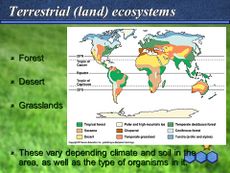Terrestrial ecology
Terrestrial ecology
Terrestrial Ecology specifies the relations of organisms and their physical environment on land. Terrestrial Ecology can be further defined through categorization of ecosystems called terrestrial ecosystems.
Terrestrial Ecosystems
Environments can be classified and categorized into several communities and these are called Biomes. Biomes, defined by [Biology-online.org,] are major ecological communities of organisms adapted to a particular climatic or environmental condition on a large geographic area in which they occur. Terrestrial biomes are the communities on land that are categorized through environmental conditions on a large geographical area. There are several terrestrial biomes to consider when studying this topic: Tundra, Taiga, Grassland, Chaparral, Desert, Tropical, and Temperate deciduous forest.
Categorizing Biomes
When studying terrestrial biomes, you may find that for categorization, biotic and abiotic factors are important. Biotic factors or biological factors are autotrophs, heterotrophs, and decomposers of a particular biome. You may remember these as producers or autotrophs, consumers or heterotrophs, and decomposers. These biotic factors evidence the differentiation in biomes, for example and in most cases, an autotroph that typically lives in a cold, wet climate would not be able to survive in a hot, dry climate such as a desert or savanna. Abiotic factors are physical components to a biome and these components affect the biological diversity and factors of the biome. In short, abiotic factors directly affect biotic factors. Abiotic factors are the unique aspects to a particular climate, the type of soil in the region, and the usage of the land.
